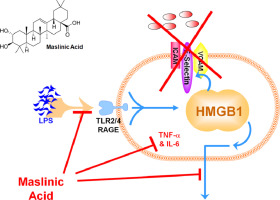当前位置:
X-MOL 学术
›
Phytomedicine
›
论文详情
Our official English website, www.x-mol.net, welcomes your
feedback! (Note: you will need to create a separate account there.)
Inhibitory functions of maslinic acid, a natural triterpene, on HMGB1-mediated septic responses.
Phytomedicine ( IF 6.7 ) Pub Date : 2020-03-04 , DOI: 10.1016/j.phymed.2020.153200 Wonhwa Lee 1 , Hayeong Lee 2 , Taeho Lee 2 , Eui Kyun Park 3 , Jong-Sup Bae 2
Phytomedicine ( IF 6.7 ) Pub Date : 2020-03-04 , DOI: 10.1016/j.phymed.2020.153200 Wonhwa Lee 1 , Hayeong Lee 2 , Taeho Lee 2 , Eui Kyun Park 3 , Jong-Sup Bae 2
Affiliation

|
BACKGROUND
Maslinic acid (MA), a natural triterpenoid from Olea europaea, prevents oxidative stress and pro-inflammatory cytokine generation. High mobility group box 1 (HMGB1) has been recognized as a late mediator of sepsis, and the inhibition of the release of HMGB1 and the recovery of vascular barrier integrity have emerged as attractive therapeutic strategies for the management of sepsis.
METHODS
We tested the hypothesis that MA induces sirtuin 1 and heme oxygenase-1, which inhibit the release of HMGB1 in lipopolysaccharide (LPS)-stimulated cells, thus inhibiting HMGB1-induced hyperpermeability and increasing the survival of septic mice. MA was administered after LPS or HMGB1 challenge, and the antiseptic activity of MA was determined based on permeability, the activation of pro-inflammatory proteins, and the production of markers for tissue injury in HMGB1-activated human umbilical vein endothelial cells (HUVECs) and a cecal ligation and puncture (CLP)-induced sepsis mouse model.
RESULTS
MA significantly reduced the release of HMGB1 in LPS-activated HUVECs and attenuated the CLP-induced release of HMGB1. Additionally, MA alleviated HMGB1-mediated vascular disruption and inhibited hyperpermeability in mice, and in vivo analysis revealed that MA reduced sepsis-related mortality and tissue injury.
CONCLUSION
Taken together, the present results suggest that MA reduced HMGB1 release and septic mortality and thus may be useful in the treatment of sepsis.
中文翻译:

天然三萜山楂酸对HMGB1介导的败血反应的抑制作用。
背景技术山楂酸(MA)是来自油橄榄的天然三萜类化合物,可防止氧化应激和促炎性细胞因子的产生。高迁移率族盒1(HMGB1)被公认为是败血症的晚期介体,抑制HMGB1的释放和恢复血管屏障完整性已成为治疗败血症的诱人治疗策略。方法我们测试了以下假设:MA诱导sirtuin 1和血红素加氧酶1抑制脂多糖(LPS)刺激的细胞中HMGB1的释放,从而抑制HMGB1诱导的通透性增加,并增加了败血症小鼠的存活率。在LPS或HMGB1攻击后施用MA,并根据通透性,促炎蛋白的激活来确定MA的抗菌活性,HMGB1激活的人脐静脉内皮细胞(HUVEC)和盲肠结扎穿刺(CLP)诱导的脓毒症小鼠模型中组织损伤标记的产生。结果MA显着降低了LPS激活的HUVEC中HMGB1的释放,并减弱了CLP诱导的HMGB1的释放。此外,MA减轻了HMGB1介导的血管破坏并抑制了小鼠的通透性,体内分析显示MA降低了败血症相关的死亡率和组织损伤。结论总的来说,目前的结果表明MA降低了HMGB1的释放和败血病的死亡率,因此可能在败血症的治疗中有用。结果MA显着降低了LPS激活的HUVEC中HMGB1的释放,并减弱了CLP诱导的HMGB1的释放。此外,MA减轻了HMGB1介导的血管破坏并抑制了小鼠的通透性,体内分析显示MA降低了败血症相关的死亡率和组织损伤。结论总的来说,目前的结果表明MA降低了HMGB1的释放和败血病的死亡率,因此可能在败血症的治疗中有用。结果MA显着降低了LPS激活的HUVEC中HMGB1的释放,并减弱了CLP诱导的HMGB1的释放。此外,MA减轻了HMGB1介导的血管破坏并抑制了小鼠的通透性,体内分析显示MA降低了败血症相关的死亡率和组织损伤。结论总的来说,目前的结果表明MA降低了HMGB1的释放和败血病的死亡率,因此可能在败血症的治疗中有用。
更新日期:2020-03-04
中文翻译:

天然三萜山楂酸对HMGB1介导的败血反应的抑制作用。
背景技术山楂酸(MA)是来自油橄榄的天然三萜类化合物,可防止氧化应激和促炎性细胞因子的产生。高迁移率族盒1(HMGB1)被公认为是败血症的晚期介体,抑制HMGB1的释放和恢复血管屏障完整性已成为治疗败血症的诱人治疗策略。方法我们测试了以下假设:MA诱导sirtuin 1和血红素加氧酶1抑制脂多糖(LPS)刺激的细胞中HMGB1的释放,从而抑制HMGB1诱导的通透性增加,并增加了败血症小鼠的存活率。在LPS或HMGB1攻击后施用MA,并根据通透性,促炎蛋白的激活来确定MA的抗菌活性,HMGB1激活的人脐静脉内皮细胞(HUVEC)和盲肠结扎穿刺(CLP)诱导的脓毒症小鼠模型中组织损伤标记的产生。结果MA显着降低了LPS激活的HUVEC中HMGB1的释放,并减弱了CLP诱导的HMGB1的释放。此外,MA减轻了HMGB1介导的血管破坏并抑制了小鼠的通透性,体内分析显示MA降低了败血症相关的死亡率和组织损伤。结论总的来说,目前的结果表明MA降低了HMGB1的释放和败血病的死亡率,因此可能在败血症的治疗中有用。结果MA显着降低了LPS激活的HUVEC中HMGB1的释放,并减弱了CLP诱导的HMGB1的释放。此外,MA减轻了HMGB1介导的血管破坏并抑制了小鼠的通透性,体内分析显示MA降低了败血症相关的死亡率和组织损伤。结论总的来说,目前的结果表明MA降低了HMGB1的释放和败血病的死亡率,因此可能在败血症的治疗中有用。结果MA显着降低了LPS激活的HUVEC中HMGB1的释放,并减弱了CLP诱导的HMGB1的释放。此外,MA减轻了HMGB1介导的血管破坏并抑制了小鼠的通透性,体内分析显示MA降低了败血症相关的死亡率和组织损伤。结论总的来说,目前的结果表明MA降低了HMGB1的释放和败血病的死亡率,因此可能在败血症的治疗中有用。











































 京公网安备 11010802027423号
京公网安备 11010802027423号